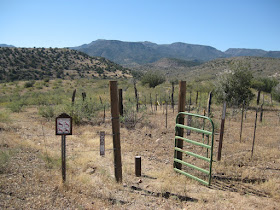Fourteen
Skyliners hiked to Verde River Falls on Saturday, 26 November 2011.
We met in the Cottonwood Safeway parking lot and loaded into
four-wheel drive vehicles. Leaving Cottonwood on Hwy 260, we drove
through Camp Verde and turned on Fossil Creek Road. We turned off
Fossil Creek Road onto FR 500 and followed it for about three miles
before turning right onto FR 9244, which we followed until it ends on
the bluff on the east side of Verde River in the area of the falls.
FR 500 and FR 9244 are four-wheel drive roads and the going is very
slow. After parking at the end of FR 9244 we passed through the gate
shown below to hike down to the river.
 |
Trailhead leading from the end of FR 9244 down to the river
|
About
a tenth of a mile ahead the trail splits and one can go right to
descend the canyon wall upstream of the falls or left to descend
below the falls. For this hike we chose to go left and followed the
trail down into a wash, reaching the bottom of the Verde River Canyon
where the wash empties into it. It was a gradual descent all the
way. However, the riverbank at this point is overgrown with thick
vegetation and it is impossible to go upstream close along the stream
bank. We instead stayed close against the cliff wall where the going
was somewhat easier, but still required us to force our way through
brush in places. About a tenth of a mile upstream from where we
entered the canyon, we came to an old meander (obviously still used
by the river during high water, but containing only a few pools of
water now) and crossed over to stop for a snack on the rocky divide
between the meander and the stream proper.
 |
Stopped for a snack on the rocky divide between a meander and the
main stream
|
After
our snack we continued on upstream toward the falls, passing a
well-camouflaged Salt River Project measuring station on the way
(below).
 |
Salt River Project measuring station with solar panels embedded in the top
|
There
are three noticeable falls along this stretch of the river; I think
the middle one is Verde River Falls. I suppose it is possible that
all three may really constitute the falls. If that is true, I am at
least approximately accurate when I call the middle one the falls.
Approaching from downstream, I stopped to take a picture of the lower
of the three.
 |
Lower of three falls along this section
|
Between
the lower and the middle falls we passed a couple of canoeists on
their way from Clear Creek to Fossil Creek. This was the second day
of their journey.
 |
Canoeists on their way from Clear Creek to Fossil Creek
|
Soon
after passing the canoeists we came to the middle and most impressive
of the falls. We paused here for a short time to take pictures and
listen to the roar of the water.
 |
Middle and most impressive of the three falls
|
A
short distance further upstream is located the third fall. We paused
there to enjoy the view then posed for a group photograph.
 |
Upper of the three falls located along this stretch of river
|
George
used the time delay feature on my camera, mounted on his small,
lightweight tripod, to take the following group photograph.
According
to my GPS the distance from the Cottonwood Safeway parking lot to
Fossil Creek Road is 23 miles, the distance on Fossil Creek Road to
FR 500 is 1.1 miles, the distance on FR 500 to FR 9244 is 3 miles and
the distance on FR 9244 to the parking area is 1.3 miles. The actual
hike distance, shown below, was only about 1.3 miles.
 |
Showing the actual hike from the parking area to the river and back
|
The
actual hike from the parking lot and back was 1.3 miles, the highest
elevation was 3099 feet and the total ascent was 495 feet.
The
included map (below) shows the
route to the falls from the Fossil Creek turnoff from Hwy 260.
Fossil Creek Road is shown in dark red, Forest Road 500 is shown in
dark magenta and Forest Road 9244 is shown in dark yellow. The hike
itself is displayed in red.














